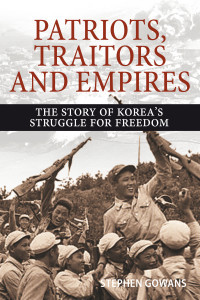
Per Fagereng welcomes author Stephen Gowans to discuss his new book Patriots, Traitors and Empires. Call in to join the conversation, pledge your support during KBOO's Spring Membership Drive and receive a copy of the book.
from Counterpunch:
Patriots, Traitors & Empires: The Story of Korea’s Struggle for Freedom, Stephen Gowans’ latest book on the Korean conflict, could not be more timely given the recent tensions on the Korean peninsula as well as the recent overtures being made for peace and reconciliation. The book is also a very good antidote to the anti-DPRK propaganda we have been fed for so many decades.
The Korean conflict, usually thought of as beginning in 1950 and ending in 1953, is one of the least known and understood conflicts in which the US has been involved. Given the lack of knowledge about this conflict, it has been easy to paint the DPRK, usually referred to as North Korea, as a rogue state led by a succession of madmen. As Gowans’ book explains, the real story is much more complex than this and indeed greatly favors the DPRK over the United States which has truly been the villain in this saga.
Gowans explains that the beginning of the Korean conflict can fairly be said to begin in 1945 when, as WWII was coming to an end, two US generals drew the arbitrary dividing line of Korea at the 38th parallel and when the US began to intervene quite deeply in what quickly became South Korea. The conflict could indeed be said to have begun even sooner as Gowans explains – that is, in 1932 when Kim Il-sung began the Korean armed resistance against the brutal Japanese occupation of Manchuria and Korea.
Kim and his fellow Koreans had much to rebel against. As Gowans reminds us, the Japanese occupation involved impressing Koreans, and Chinese as well, into forced labor as well as into sexual slavery. By 1938, Gowans explains, “30,000 to 40,000 women, mainly Koreans, [were] subjected to regular sexual violence by Japanese soldiers.”
As it would do in other countries such as Greece and throughout Latin America, the US turned to the most reactionary, and indeed fascist, elements of South Korea to keep it safe from socialism and open to economic exploitation. Specifically, the US turned to traitorous Koreans who collaborated with Japan during WWII to lead South Korea.
- KBOO


